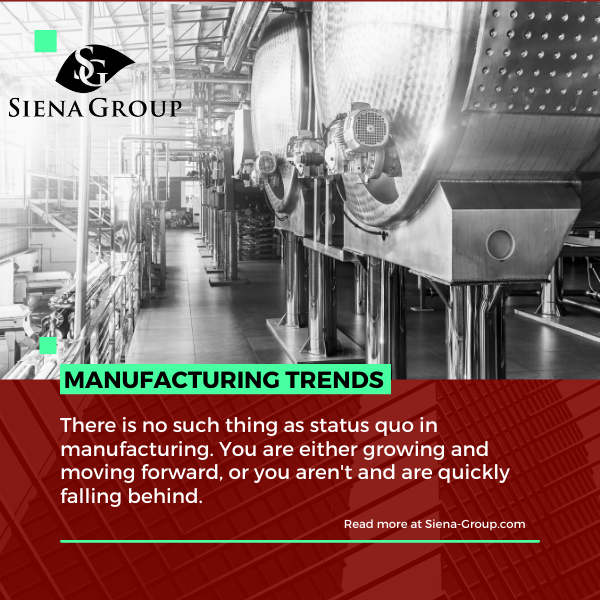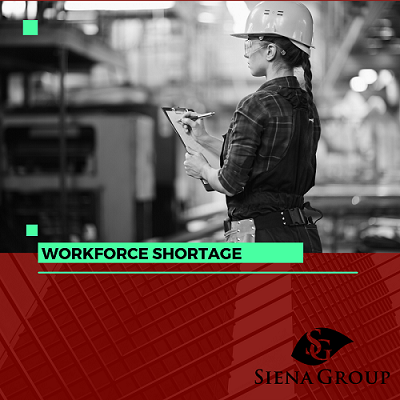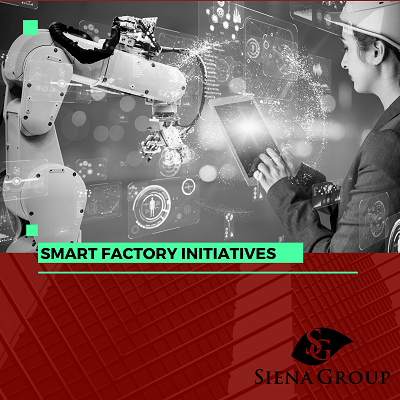Manufacturing Trends: Looking Out for Outlooks
by Keith Brown, President & Owner, Siena Group.

With the 3rd Quarter over halfway finished, it’s always good to pause & take stock.
- Pause to look back at what 2022 was anticipated to be
- Pause to look within to assess & refresh the way we do business
- Pause to look forward to what the next quarter will bring
I believe that the best way to unpack 2022 is to start at the beginning with an insightful article by Deloitte on manufacturing industry trends. This article really nails it! I recommend downloading and reading through it. Here are my thoughts on the five manufacturing industry trends as they relate to the right-here/right-now.

ONE. WORKFORCE SHORTAGE: Preparing for the future of work could be critical to resolving current talent scarcity.
“Manufacturing executives may also need to balance goals for retention, culture, and innovation. As flexible work is taking root in offices, manufacturers should explore ways to add flexibility across their organization in order to attract and retain workers. Organizations that can manage through workforce shortages and a rapid pace of change today can come out ahead.”
Deloitte
I believe this manifests in multiple ways. Not only are we facing a talent crunch, the pandemic fundamentally shifted priorities. The Millennial generation more highly values relationships. Though inherent to that large swath of people, many others came to view their priorities in a different way which has made relocation one of the biggest obstacles to overcome when recruiting talent.
Key recommendations are:
- Organizations must shift their views on the needed skill set for a particular role and compromise in order to bring on someone that is local. The time it takes to find a 95% fit is significantly longer than finding an 80% fit locally. Absolutely ensure that the culture, style, and fit align but give a little on the technical side. People are resilient and adaptable. Trust them to quickly make the needed adjustment. If you hold out for the “perfect fit,” be prepared to be patient in this market! People just don’t want to relocate if they don’t have to.
- For more senior-level roles or those that will end up on the road supporting multiple sites, companies need to be flexible with the need to relocate the person to corporate. Yes, that would be ideal… but this isn’t an ‘ideal’ market. I’ve worked with large, medium, and small companies, and those that have made this shift in mindset and provided the necessary tools to assist connectivity and aligned expectations about making the extra trip to corporate as needed have landed some truly extraordinary talent that they would not have if they forced a relocation.
[Read the August Thermoforming Report for an in-depth conversation on remote vs hybrid vs onsite manufacturing jobs.]

TWO. SUPPLY CHAIN INSTABILITY: Manufacturers are remaking supply chains for advantage beyond the next disruption.
“Supply chain challenges are acute and still unfolding. Root causes for extended US supply chain instability may include overreliance on low inventories, rationalization of suppliers, and hollowing out of domestic capability. Supply chain strategies in 2022 are expected to be multipronged. Digital supply networks and data analytics can be powerful enablers for more flexible, multitiered responses to disruptions.”
Deloitte
If you haven’t seen the Jack Nicholson meme, you’ve not been paying attention… or you are part of the supply chain world and can’t even look up!

As a manufacturing-industry-leader-turned-recruiter/talent partner, I’m always visiting & revisiting trends and forecasts – and supply-chain issues are a common theme.
The amount of challenge and stress within the supply chain is pretty much unprecedented. With these ever-pressing challenges, many manufacturers are reworking and remaking their networks for their advantage — beyond the next disruption. The interconnectivity of manufacturing and supply chain requires a sustained focus on increasing efficiency and efficacy – in a myriad of ways.
Here are my two cents… with some help from industry news & muse:
- Network. Every once in a while, try to lift your head. Yes, it may feel all-consuming, but it’s essential for manufacturers to look beyond their factory doors for leadership insight and for continued growth. Create a niche-specific network to gain perspective into what’s working and what’s not. Join an industry-specific LI group. Follow industry leaders and out-of-the-box thinkers. Utilize such tools as the Global Supply Chain Pressure Index, published by the Federal Reserve Bank of New York, to guide next steps. Things are looking up!
- Be Transparent. According to a recent survey published in Plastics Today, 59% of manufacturers indicated that improving supply-chain visibility was their single most important business priority. Manufacturers need to provide greater transparency around how their products are sourced. This is where new technologies come in, enabling manufacturers to streamline production costs!
- Expand and Innovate. Manufacturers need to expand their vendor & supplier network and identify alternatives and substitutes so that they can minimize the downtime caused by supply-chain congestion. As we all know too well, the pace of innovation is extraordinary, and manufacturing organizations have been slow to adapt. Those that do will have a significant competitive – and financial – advantage over their competitors. This is where connectivity and creativity facilitate growth & possibilities!
- Be nimble and flexible. This is not easy to accomplish – but it is critical. It is much harder to achieve in regulated environments and those with strong change control systems in place. That said, having solid secondary sources at the ready will smooth out the inevitable interruptions. Leverage your network (see above), be creative (see above), and build into your systems the right amount of flexibility so that response time is short and interruptions are minimized. And make sure your entire organization is on board with this approach and strategy so that those barriers are already overcome.
- Invest in people. I just can’t say this enough! Having the right leaders and individual contributors in the right places that are tuned in and informing key decision makers is critical. As usual, it boils down to how organizations leverage their most important asset: people. It’s hard to learn new things in order to grow and advance, especially when there is this much chaos in the global supply chain. But making the time, investing resources, and doing these five things will enable a healthy and thriving business with a bunch of happy, satisfied, and committed team members and customers.
The key takeaway: “flexible, multi-tiered responses” isn’t just desired, it is absolutely imperative!

THREE. SMART FACTORY INITIATIVES: Acceleration in digital technology adoption could bring operational efficiencies to scale.
“Manufacturers looking to capture growth and protect long-term profitability should embrace digital capabilities from corporate functions to the factory floor. US manufacturers have room to run with advanced manufacturing compared to many competitors globally. Advanced global “lighthouse” factories showcase the art of the possible in bringing smart manufacturing to scale. Investment in robots, cobots, and artificial intelligence can continue to transform operations. Foundational technologies such as cloud computing enable computational power, visibility, scale, and speed. Industrial 5G deployment may also expand in 2022 along with advances in technology and use cases.”
Deloitte
Technology is nothing new in manufacturing. Applying innovative techniques and approaches is part and parcel with how US manufacturing has grown and dominated the world platform over the decades. As we all know too well, the pace of innovation is extraordinary, and manufacturing organizations have been slow to adapt. Those that do will have a significant competitive – and financial – advantage over their competitors. Three trends that I keep seeing and hearing:
- Leveraging and applying IoT is critical. Unfortunately, I am not able to speak into this with any authority with one exception – I’ve been asked to search and seek out talented people that can bring that technology to bear on the manufacturing floor.
- 3D printing is an advantage. 3D printing is another tool that is not necessarily on the cutting edge anymore but, if applied correctly, has allowed and enabled smaller companies to quickly produce unique prototypes in partnership with their clients and landed and/or secured new business as a result. It isn’t hard – you just need the right people in the right places with leadership buy-in to take advantage of this technology.
- AI is altogether new in the manufacturing world. Again, not a new concept but the application of technology within and on the manufacturing floor is novel. I am not an expert, but I’ve been tasked with exploring and locating this skill set of late. Asking the right questions is important and realizing how to truly apply this to manufacturing processes is not common in the industry… yet.
[Read the September Thermoforming Report for an in-depth conversation on Smart Factory Initiatives in Manufacturing.]

FOUR. CYBERSECURITY: Rising threats are leading the industry to new levels of preparedness.
“High-profile cyberattacks across industries and governments in the past year have elevated cybersecurity as a risk management essential for most executives and boards. Manufacturers should look not only at their cyber defenses, but also at the resiliency of their business in the event of a cyberattack. Cybercriminals can cause harm beyond intellectual property theft and financial losses, using malware that now ties in AI and cryptocurrencies. They can also shut down operations and disrupt entire supplier networks, compromising safety as well as productivity. A patchwork of regulations for different industries could be consolidated under the current administration’s “whole-of-nation” approach to protect critical infrastructure. The potential for additional oversight is likely to prompt more industrials to rethink preparedness for crisis response.”
Deloitte
As a small business owner, I’m pretty sure I’m not on anyone’s radar to be attacked. That said, I absolutely take this stuff seriously! I have 3 different types of redundancies in place in order to ensure seamless support for my clients in case something happens. What is more likely in my world is a system/component failure and not a cyber-attack. However, it doesn’t take long to think about the implications of a system-wide attack and the obvious need to mitigate those risks – just review the two high-profile cases that have hit in the past couple of years (Colonial Pipeline comes to mind). Additionally, as new technologies are applied (number Three that was just highlighted above), ensuring that interconnected devices are secure becomes all the more important as exposure is dramatically increased.

FIVE. ESG INVESTMENT: Manufacturers are likely to bring more resources and rigor to advancing sustainability.
“The fast rise of environmental, social, and governance (ESG) factors is redefining and elevating sustainability in manufacturing as never before. Depending on a manufacturer’s end markets, environmental accountability is increasingly a focus. To develop and deliver against net-zero or carbon-neutral goals, more organizations are dedicating or redesigning sustainability roles and initiatives and quantifying efforts and results around energy consumption. And the fast-evolving ESG landscape may require close monitoring in 2022 for manufacturers. Many organizations are complying voluntarily within a complex network of reporting regulations, ratings, and disclosure frameworks. But regulators globally are also moving toward requiring disclosure for more nonfinancial metrics. Proactive approaches may help manufacturers stay ahead of the change and create competitive advantage.”
Deloitte
Boy, is this one big! With the constant pounding of the negative drumbeat of plastics, there is a lot to overcome in our world of thermoforming! Perception is reality, and it is very difficult to educate your customers with the facts versus what is constantly being shared on every social media platform that exists. Regulations and newly enacted laws that will start in various locations in the US and globally in the near future are tough to keep up with. How do you navigate this crazy environment?!? My short answer is people: having the right people in the right places that are tuned in and informing key decision makers is imperative. And then act on that information – do the right things for the right reasons.
Here are my two cents:
- Messaging is crucial. We need to continue to have smart people highlight all the great things the industry is doing to ensure sustainability and environmental accountability. But that isn’t enough – it needs to also be communicated and shared broadly to combat all the other noise.
- Invest in new technologies to drive out waste. Without getting into a full soapbox on World Class Manufacturing principles, building quality within the processes is a great start. Doing it right the first time is the smart way to run a business. Spend the money to improve. Ask your team members how to make things better. Implement those things in number three above to streamline and provide key information to make better decisions.
- Innovate and be willing to try different things. This could be through processes to reduce waste all the way to innovating ways to change the raw materials to a new and fully compostable polymer. [If you are interested, I work with a business owner that has created this very thing – just contact me for more info!]
It is hard to stay current with the trends. When you are in manufacturing, you tend to have your head down and focused on the goals. There are a lot of plates to keep spinning and investing the time to stay tuned in to things outside of your world is tough. As leaders, however, we absolutely must do this! Things are changing quickly and staying in touch must be planned into our work life. There is no such thing as status quo in manufacturing – you are either growing and moving forward… or you aren’t and are quickly falling behind.
Share our post with others
Love what you see? Share it with your connections now.
